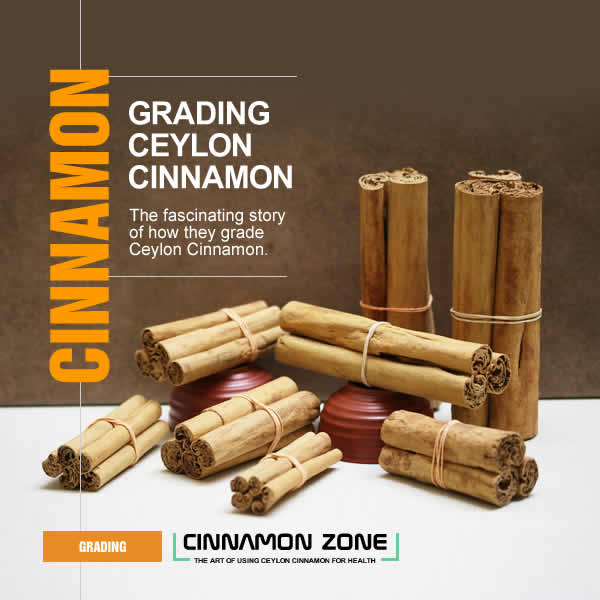

![]()
CEYLON CINNAMON GRADES
While Ceylon Cinnamon sticks are all made the same way, they are graded according to color, density, blemishes, essential oil content and other factors. So it is important you understand these quality standards called the SLS-81 standards set by the Sri Lankan government. It will help you select the best quality Ceylon Cinnamon for your needs.

Ceylon Cinnamon sticks are also known as quills. After harvesting and drying, cinnamon quills curl while the much harder cassia has a single scroll-like curl. Ceylon Cinnamon (True cinnamon) has a tan color compared to the dark red-brown of cassia Cinnamon.
High quality Ceylon Cinnamon sticks should be like a fine cigar, with uniform thickness, color, quality and clean edges. The sticks should be firm and compact without bark residue, made by rolling thin layers of good quality Ceylon Cinnamon pieces.
The Cinnamon sticks should also have minimal foxing, which is a term used to describe reddish-brown warps caused by dampness. The more foxing there is, the lower the quality of the Cinnamon.
In Sri Lanka, minimal foxing is called “ Malkorahedi ” while heavy foxing is called “ Korahedi ”. Whether a cinnamon sticks is called Malkorahedi or Korahedi is based on the extent of the foxing patches. Each grade of Cinnamon has certain foxing specifications.
According to the spice Council of Sri Lanka SLS-81 standard Cinnamon can should have a maximum moisture content of 15%. Ideally it should be less than this, The essential Oils in Cinnamon sticks which determines the aroma, is specified at a minimum of 1%.
Ceylon Cinnamon sticks are sometimes “ bleached ” with Sulphur to clean and kill of any insects. They also do this to made the Cinnamon sticks looks nicer. But this practice is increasingly become less and less especially for the European and American market which demand salt free Ceylon Cinnamon sticks. For the Mexican bleaching with Sulphur is common, as a cost effective ways of reducing contamination and insects.
Chips, referred to as “quillings” and “featherings,” are sold as for grinding into cinnamon powder, sold on its own or as “pudding spice” in a compound with nutmeg, clove, cardamom, mace and allspice.
The chips are also sold for the distillation of oil. Higher quality Cinnamon Oils are extracted from the top grades of Cinnamon chips which has more oil content of higher quality (Cinnamaldehyde).
Cinnamon is also graded according to its diameter, tightness of the curl, color, flavour (based on oil content) and appearance (Foxing). Usually the larger diameter has a looser curl which less densely packed cinnamon. The smaller diameter Cinnamon sticks becomes progressively denser. with pieces of Cinnamon packed really tight and then curled into a stick.
Whole cinnamon has a significantly longer shelf life than ground cinnamon. The most typical raw cinnamon products are sticks; quillings (pieces of bark of remaining from the preparation of quills) featherings, the inner bark of discarded twigs and shoots; chips, trimmings from quills and inseparable inner and outer bark, cinnamon powder, cinnamon bark oil and cinnamon leaf oil.
BUYING CEYLON CINNAMON STICKS
Because of the huge variation in quality buyers should be carefull where they buy Ceylon Cinnamon sticks from. Even Amazon has all manner of bogus Ceylon Cinnamon retailers.
Even organic Ceylon Cinnamon can be prone to fraud. It maybe organic but if the product has high ash content or low volatile oil content it does not really matter if it is organic. It is useless and gives little of the benefits of Cinnamon.
| Name | Maximum allowed diameter in mm |
Whole sticks (1050 mm) per kg |
Maximum Foxing % Allowed |
| Alba Grade | 6 | 45 | 0 |
| C5 Extra Special |
8 | 33 | 19 |
| C5 Special | 10 | 30 | 10 |
| C5 | 12 | 27 | 15 |
| C4 | 16 | 22 | 15 |
| C3 | 18 | 20 | 20 |
| M5 Special | 16 | 22 | 60 |
| M5 | 18 | 20 | 60 |
| M4 | 21 | 15 | 60 |
| H1 | 23 | 11 | 25 |
| H2 | 25 | 9 | 40 |
| H3 | 38 | 7 | 60 |
| Source - Sri Lanka Spice Council SLS-81 Standard | |||
 |
 |
 |
|---|---|---|
 |
 |
 |
 |
 |
 |

